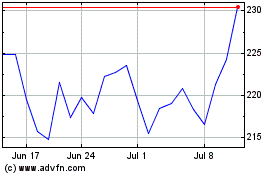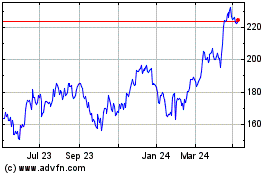By Ellen Emmerentze Jervell
HERZOGENAURACH, Germany-- Adidas AG on Saturday plans to lift
its street cred by releasing the third version of its popular Yeezy
Boost shoe with rapper Kanye West.
The launch also banks on something the beleaguered sports
company can market without hip-hop stars: geeky German
engineering.
Adidas has struggled for years to regain its cool status,
particularly in the U.S. Its design and marketing cooperation with
Kanye West, begun this year, has helped somewhat, analysts and
sneaker fans say.
To boost the new shoe's air of exclusivity and draw attention,
Adidas is deliberately releasing far fewer of the model than the
market seems to want. At some footwear stores around the world,
eager shoppers have camped out for days.
Adidas hopes the tactic will add allure to the rest of its
product line.
"Only a very limited number of people who want the new shoes
will be able to get them," an Adidas spokeswoman said. "But they
might buy other Adidas pairs."
Online magazine sneakernews.com on Tuesday published an article
titled "11 Adidas shoes you can buy instead of the Yeezy
Boost."
The buzz is a welcome change for Adidas, which repeatedly cut
its profit outlook in 2014 amid sagging demand. It has lost market
share for years to U.S. rival Nike Inc. and more recently to
newcomer Under Armour Inc.
While Boost shoes may provide "a weapon for Adidas's
resurgence," they are just one element of a bigger turnaround, said
Robert C. Walcott, a professor of entrepreneurship and innovation
at Northwestern University's Kellogg School of Management in
Chicago.
One reason the Boost shoes have sparked optimism for Adidas is
that it isn't marketing them on trendiness alone. Boost soles use a
proprietary plastic from German chemicals giant BASF SE that the
companies say provides demonstrably superior athletic
performance.
"It is a unique and credible technology," said Matt Powell, a
sports industry analyst at NPD Group.
BASF in 2009 approached Adidas with the new plastic and the
sportswear firm was "quick to come up with ideas," said Martin
Vallo, BASF's account manager for Adidas.
Gerd Manz, senior innovation director at Adidas, recalled that
when he first measured the performance of soles made from the
plastic, his "blood pressure rose."
Pounding the material to simulate running and jumping, he saw
that it released far more of the energy input than any other sole
material he knew of. The result could be higher leaps and springier
strides.
"I got that we were onto something," he said.
The innovation prompted a debate inside Adidas over how to
market the material, which resembles a bubbly version of
polystyrene used in coffee cups and looks "very different" from
other sneaker soles, Mr. Manz said.
Adidas eventually decided to play up its new plastic. For its
first use, the Energy Boost running shoe, Adidas added "Boost" to
the name and left the distinctive material exposed. At the launch
in February 2013, Adidas executives focused on the foam's energy
return and cushioning abilities.
Marketing shoes' materials and performance marks a return to
tactics of Adidas's glory days. Company founder Adi Dassler already
in the 1930s was known for his close cooperation with athletes to
create functional products, a rarity at the time.
Adidas struggled with its approach in the 1980s when Nike
started appealing to consumers' emotions with shoe monikers like
"Air" and, more recently, "Free." The German company, focused on
soccer and engineering, struggled to connect emotionally with
American consumers, industry officials said.
Boost allows Adidas to play to its technical strength amid
renewed consumer interest in performance and product quality,
company officials say.
"Materials and functionality have always been at the core of
what we do, " said Maarten Teijsee, vice president Adidas head
office.
Industry experts said Adidas's retro approach is particularly
relevant to athletes focused on performance.
"Runners do care about what kind of plastic is under their
shoes," said Sven Reinecke, executive director of University of St.
Gallen's marketing institute in Switzerland. Mr. Reinecke said
Adidas is using Boost to differentiate its offerings from
competitors'. Adidas plans to double its running shoe sales by
2020.
Adidas got lucky in late 2013 when Mr. West quit his endorsement
deal with Nike for the German company and began appearing in public
wearing Boost shoes. The rapper, sometimes nicknamed Yeezy, gave
the high-performance running shoes mass appeal.
American pop culture magazine Complex last year named the Pure
Boost, one of Mr. West's favorite models, "the best sneaker of
2014."
Mr. West launched his first clothing and sneaker collection for
Adidas's Originals unit with a fashion show in New York in
February. He has since launched two different Yeezy Boost sneakers,
the first revealed through a carefully planned social media
leak.
Mr. Powell said Boost already has helped prop up some of
Adidas's weaker businesses in the U.S. Now, he added, the company
is using Mr. West to introduce the material to a broader
audience.
Erik Fagerlund, co-founder of sneaker retailer Sneakersnstuff,
which also plans to sell a limited number of Yeezy Boost shoes
online and at its stores on Saturday, said Adidas's Boost soles are
recognized by knowledgeable consumers and give the collaboration
more credibility.
"Today it is not hard to create shoes," he said. "But to create
functional sneakers is not as easy."
In 2013, Adidas sold 1.5 million pairs of Boost shoes. Since
then it has used the material in footwear for basketball, baseball,
snowboarding, skateboarding and golf. The company said it hopes to
sell 12 million Boost pairs this year, in part thanks to Mr.
West.
Christopher Alessi
contributed to this article.
Subscribe to WSJ: http://online.wsj.com?mod=djnwires
(END) Dow Jones Newswires
August 20, 2015 11:59 ET (15:59 GMT)
Copyright (c) 2015 Dow Jones & Company, Inc.
Adidas (TG:ADS)
Historical Stock Chart
From Mar 2024 to Apr 2024

Adidas (TG:ADS)
Historical Stock Chart
From Apr 2023 to Apr 2024
